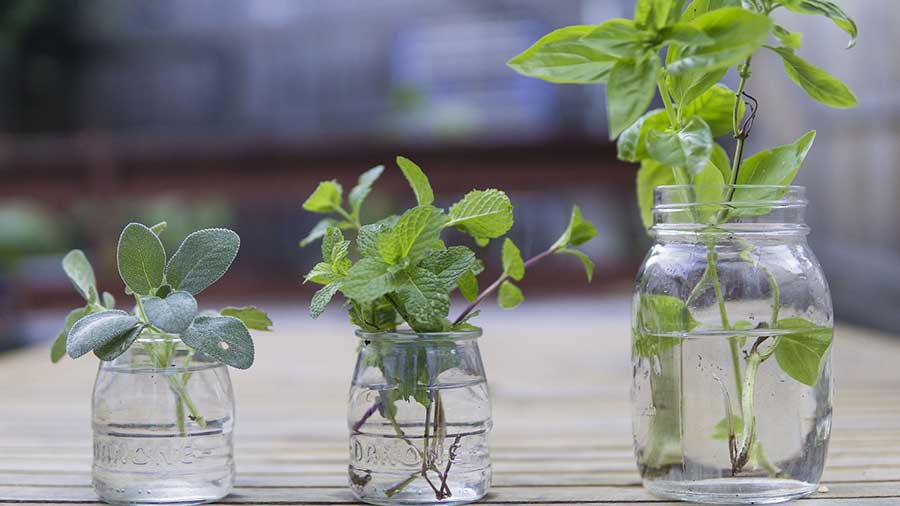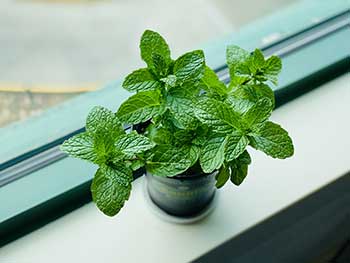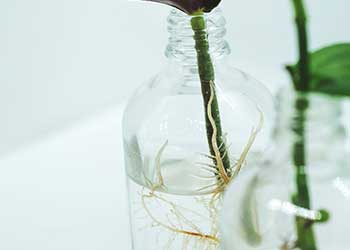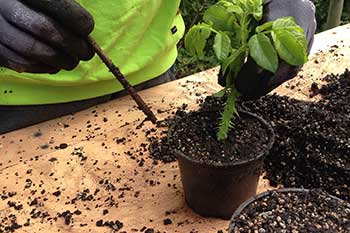One group of plants that I really like to grow is herbs. They are packed with nutrients and healing benefits. It’s also satisfying that you can just pluck some leaves of your favorite herb from a windowsill planter in your kitchen and add it to whatever you are cooking. For me, I use it in my pasta, salads, and soups.
I have successfully grown herbs from seeds. However, planting from seeds take time before I can harvest them. Sometimes, I have no available containers to use for potting, or I run out of garden soil, so planting from seeds is not an option. In this case, what I do mostly is to propagate or grow herbs through cuttings.
When you do the cutting method, you are really trying to grow the roots in water. This method saves me time (normally about a month) in growing herbs until maturity. This also ensures that I will have a yearlong supply of herbs for my kitchen.
Another good thing about cuttings is that I can grow my herbs indoors.
Here are the herbs that can be grown from cuttings
- Basil
- Lemon balm
- Oregano
- Peppermint
- Rosemary
- Sage
- Stevia
- Tarragon
- Thyme
Basil
A tender plant with alternating broad, light green leaves, basil is prized in Asian and Italian cuisines. Known for its distinct aroma, basil contains a variety of essential oils. Fresh leaves taste sweet and peppery.
- Tip for cutting basil: Cut the stems before the parent plant flowers
Lemon balm
It is often used for culinary purposes to make teas, marinate chicken or fish, or flavor baked foods and jams. Lemon balm is also believed to treat a range of medical disorders affecting the digestive tract, nervous system, and liver.
- Tip for cutting lemon balm: It is best to cut the stems during wet or cold season
Oregano
Oregano has a sweet aromatic flavor. With its Mediterranean heritage, it's the ideal herb to use in Italian and Spanish-style dishes. Oregano is a grab-and-go herb that pairs well with chicken, scrambled eggs, baked eggplant, burgers, and even fish.
- Tip for cutting oregano: Like basil, cut oregano before the parent plant flowers
Peppermint
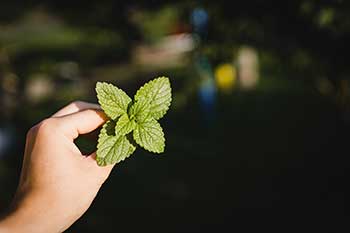
Peppermint is often an ingredient in candies, chocolates, gums, ice creams, jellies, syrups, teas, and other confections. Its scent is said to have a calming effect. The tisane or infusion of the peppermint can be gargled to prevent bad breath.
- Tip for cutting peppermint: Just cut the stems and place them in water
Rosemary
It doesn't only give you fresh herbs to cook with but is a pretty bush with a wonderful aroma. Thanks to the fine aroma, its branches are used in cookery for the preparation of many dishes. The substances which are contained in rosemary improve mood, reduce stress, and helps condition your skin.
- Tip for cutting rosemary: This herb takes a while to grow because of its thick stem. It likes a sunny spot
Sage
Sage is a perennial, evergreen sub-shrub, with grayish-green color and lance-shaped leaves. It has a high antioxidant capacity to protect the body’s cells from damage that may lead to cell death, a weak immune system, and chronic diseases. It has also anti-inflammatory, anti-fungal, and anti-microbial effects that are beneficial to human health.
- Tip for cutting sage: Like peppermint, just cut the sprigs and place them in water
Stevia
Stevia leaves taste sweet, sometimes with a bitter or licorice-like aftertaste. The sweetness naturally comes from over 40 compounds, known as steviol glycosides. The leaves can be dried, crushed, and used as sweeteners. It is sometimes called sweet leaf or candy leaf herb.
- Tip for cutting stevia: Cut the stems and put them in water. They love warm spots
Tarragon
Tarragon is a licorice-flavored herb that is often used to flavor meats or egg dishes. It is used both fresh and dried. Tarragon is a hardy herb usually grown for its leaves and its aromatic flavor. Tarragon plants can reach up to 3 feet tall. The herb has long, light green leaves and yellow or white flowers.
- Tip for cutting tarragon: Cut stem after fresh growth appears. Like stevia, tarragon loves warm, sunshiny spots
Thyme
Thyme is one of the most commonly used herbs in the world. You can grow it in your garden and use it fresh or dried in all kinds of dishes. The flowers, leaves, and oil are used as medicine. Thyme is sometimes used in combination with other herbs.
- Tip for cutting thyme: Take cuttings before parent plant flowers appear
Steps to Propagate Herbs by Cutting
Now let's go to the fun part. Follow the steps below for rooting your plant cuttings in water.
- Cut the herb and put it in a wide-rim glass jar. It is best to cut off healthy young shoots with scissors or break off with your hand

- Choose rain or tap water that has been left overnight. Rainwater is perfect for most house plants, especially if the tap water is hard. Leaving tap water overnight tends to lower its chemical content, especially chlorine.
- Prepare the cuttings by nipping off the lower leaves. You just need a few at the top of the cutting. Trim just below the bottom leaf joint. Leaves submerged in water will just rot.
- Put a handful of cuttings into the glass jar so that the stems are covered with water. To encourage the roots to grow from the cuttings, place it on a warm, light window ledge or where there is a bright light. You can easily grow the cuttings indoor just by placing them on a windowsill.

- Don’t forget to change the water at least once a week.
- After a while, you will see tiny roots starting to appear from the leaf joints along the submerged stems. Allow these to grow a little more.
- When roots start to come out, don’t change the water.
- When a good root system has developed, pot the cuttings up. You have now successfully rooted your cuttings in water!

Transferring a Plant Cutting from Water to Soil
You may let the plant grow in water or plant it in soil. If you decide to let it grow on water, you may have to add liquid additives to supplement the nutrients of the plant. Also, you have to make sure to maintain the level of water inside the jar.
If you decide to transfer it to soil then you can do the following steps:
- Break up any large clumps of soil to improve drainage. You may need to add garden compost if the soil is a heavy clay type. Other soil amendments you can use are coco peat, sawdust, wood shavings, or dried animal manure.
- Fill in the pots with loam-based potting compost or topsoil. This will give the young plants a chance to root freely.

- Firm lightly and level off with your hands
- Water frequently for the first 2 weeks. Make sure to keep the soil moist for this time period.
- To keep your plants healthy, pick the leaves and soft stems of the edible kinds frequently, especially parsley and mint.
- If you leave herbs to flower, they attract pollinating insects, but this makes the foliage of edible kinds less tasty.
Planting herbs is truly a wonderful experience. Nothing beats planting your own herbs at home and picking them fresh from your garden to your kitchen.


